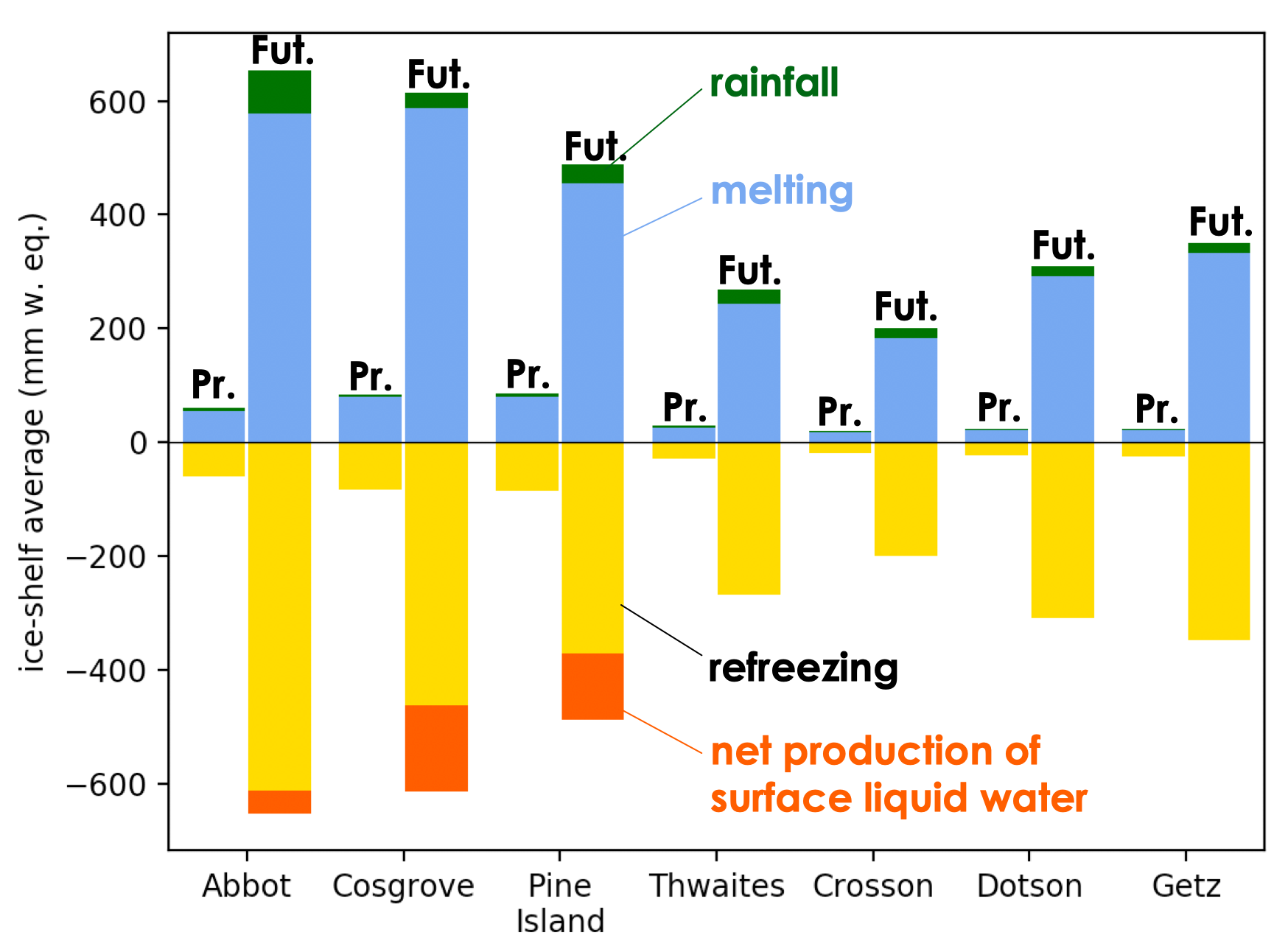New article on surface accumulation and surface melting
New paper supported by TROIS-AS and PROTECT: Donat-Magnin et al. (2021).
Projections
Using a 10km MAR configuration that was thoroughly evaluated in Donat-Magnin et al. (2020), we have built projections of surface mass balance (SMB) and surface melt of the Amundsen sector of West Antarctica, to 2080–2100, based on the CMIP5 multi-model mean under the RCP8.5 scenario.
SMB over the grounded ice sheet in the sector between Getz and Abbot increases from 336 Gt/yr in 1989-2009 to 455 Gt/yr in 2080-2100, which would reduce the global sea level changing rate by 0.33 mm/yr. Snowfall indeed increases by 7.4 to 8.9% per °C of near-surface warming, due to increasing saturation water vapour pressure in warmer conditions, reduced sea-ice concentrations, and more marine air intrusion.

Ice-shelf surface melt rates increase by an order of magnitude in the 21st century, mostly due to higher downward radiation from increased humidity, and to reduced albedo in the presence of melting. However, most melt water refreezes in the firn, even in the future run. Hence, significant amounts of surface liquid water (produced after warming of the snowpack and depletion of the firn air content by melt water) are only found over Abbot, Cosgrove and Pine Island ice shelves at the end of the 21st century. All the ice shelves from Thwaites to Getz are projected to remain nearly free of surface liquid water throughout the 21st century. The melt-to-snowfall ratio explains regional contrasts in our projections, and the net production of surface liquid water becomes significant if this ratio exceeds 0.60 to 0.85.

Assuming that a net production of surface liquid water over a year is a necessary condition for hydrofracturing, this suggests that western ice shelves might remain unaffected by hydrofracturing for more than a century under RCP8.5. In contrast, eastern ice shelves have a high potential for hydrofracturing before the end of this century as they experience a net production of surface liquid water at the end of the 21st century.
Based on the melt and snowfall dependencies to near-surface warming, we have extrapolated our projections further in time and for other scenarios. Although uncertain, this suggests that most ice shelves could remain free of surface liquid water by 2100 under RCP2.6 and RCP4.5, to the exception of Cosgrove. Under RCP8.5, the ice shelves from Thwaites to Getz may only experience net production of surface liquid water in the second half of the 22nd century, and possibly the 23rd century in the case of Crosson. These results suggest that for Getz, Dotson, Crosson and Thwaites, ice-shelf collapse is unlikely to be triggered by hydrofracturing before the 22nd century. Nonetheless, it does not mean that these ice shelves will not collapse through other mechanisms, in particular ocean-induced basal melting, as observed and projected for Thwaites (e.g. Milillo et al., 2019; Yu et al., 2019), with positive feedbacks to ice damage and ice discharge (Lhermitte et al., 2020).

Methods
The method used to build our projections consists of adding the seasonal climate change anomalies (2080-2100 minus 1989-2009) of the CMIP5 multi-model mean to the present-day surface and lateral boundary conditions of MAR. This method has the advantage to start from a present-day state that is not affected by present-day biases in CMIP5 models and to be applicable to a multi-model-mean projection. Considering all these anomalies together allows keeping the consistency of linear relationships, such as the geostrophic and thermal wind balances, although it does not necessarily conserve non-linear relationships. The multi-model mean is often considered as the “best” estimate for future climate because individual model biases are partly cancelled. Given that the CMIP model biases are largely stationary even under strong climate changes (Krinner and Flanner, 2018), our method is also expected to remove a part of the biases in individual model projections.
To evaluate the ability of our projection method to capture the future climatology, we have run a perfect-model test (i.e. assuming that the future is perfectly known by considering that a given projection, here ACCESS-1.3 is true). This shows that our projection method may lead to a 16-17% underestimation of projected SMB and melt rates. Such errors should not strongly affect the melt to snowfall ratio, which gives confidence in our projections of potential hydrofracturing in the Amundsen sector.
Reference
Donat-Magnin, M., Jourdain, N. C., Kittel, C., Agosta, C., Amory, C., Gallée, H., Krinner, G., and Chekki, M.: Future surface mass balance and surface melt in the Amundsen sector of the West Antarctic Ice Sheet, The Cryosphere, https://doi.org/10.5194/tc-2020-113, in press, 2021.